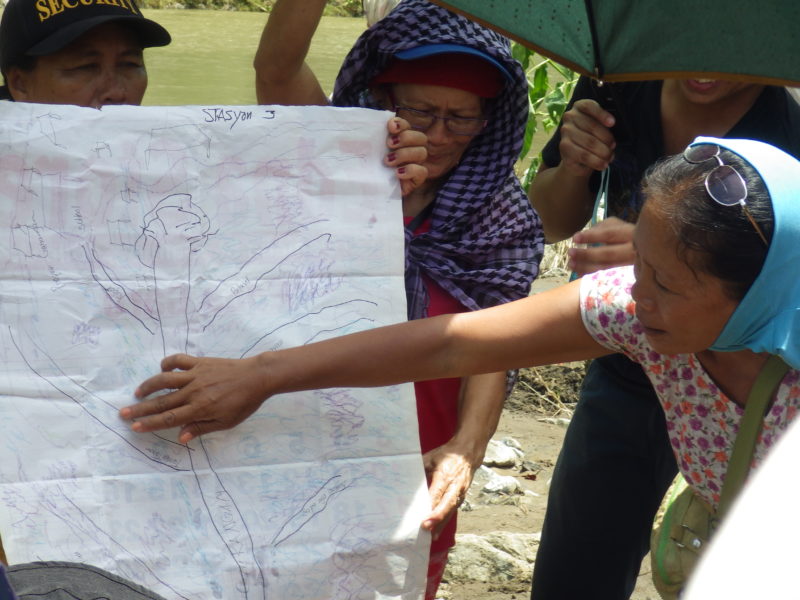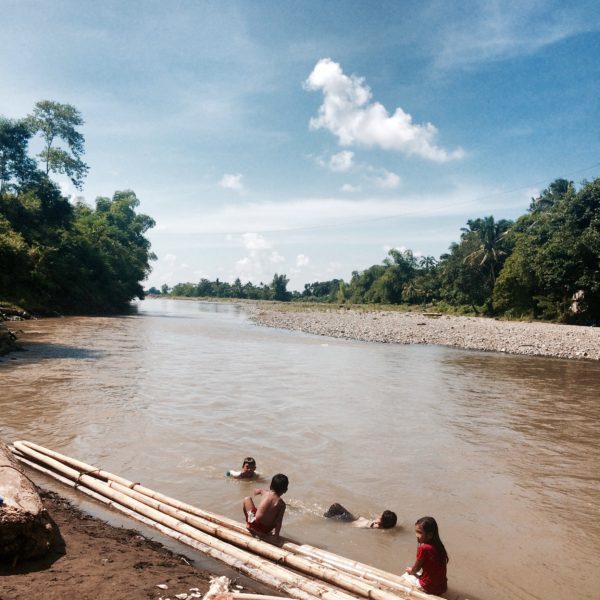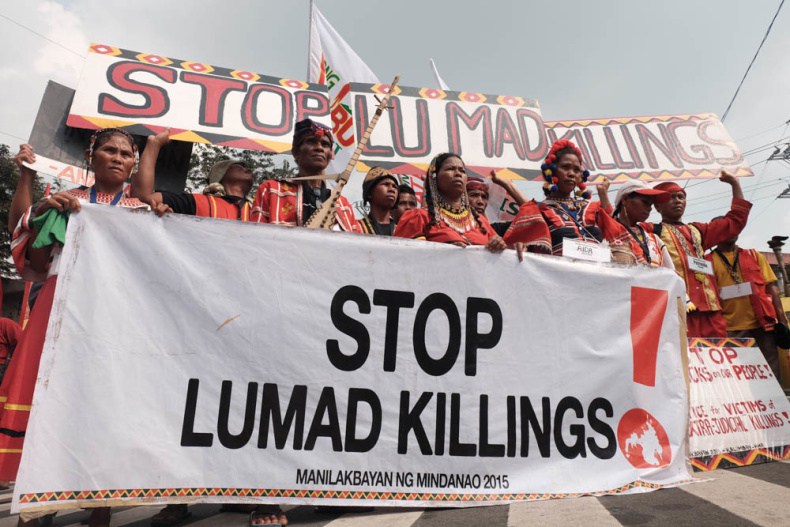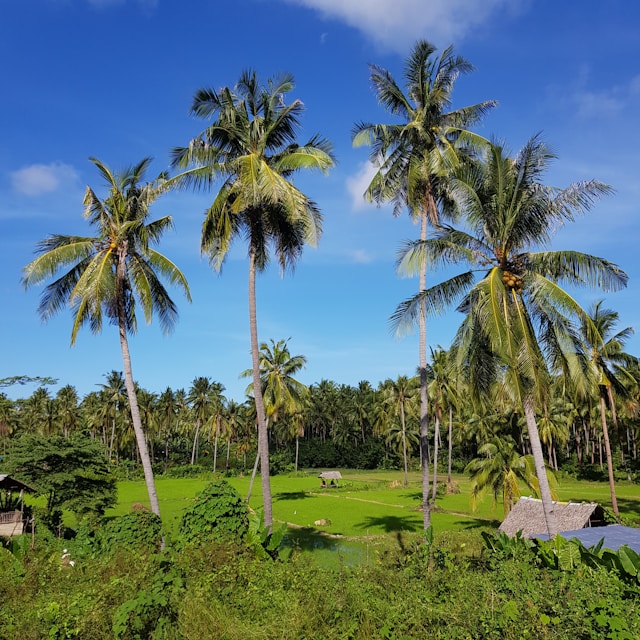
by Deep Green Resistance News Service | Aug 19, 2016 | Biodiversity & Habitat Destruction, Colonialism & Conquest
Featured image: International Solidarity Mission delegates listen to testimonies by Tumandok men and women in Barangay Agcalaga, Calinog. Photo Credits: Jalaur River for the People Movement.
By Karlo Mikhail Mongaya, GlobalVoices
The Tumandok (Panay-Bukidnon) indigenous peoples of the central Philippine Island of Panay are facing the real possibility of being forced from their homes due to the construction of the Jalaur Mega Dam, which will leave indigenous communities in the municipality of Calinog, Iloilo underwater.
Also known as the Jalaur River Multipurpose Project Phase 2 (JRMP II), the project is expected to displace 17,000 Tumandok individuals, affecting 16 indigenous people’s communities. The building of the dam will submerge houses and agricultural lands of the Tumandok.
These were the findings of the International Solidarity Mission (ISM) from July 16 to 18 organized by the Jalaur River for the People Movement. Delegates representing 26 organizations from five countries, including Belgium, Germany, Italy, Philippines, and South Korea, took part in the ISM.
The ISM delegates trekked to the indigenous communities along the Jalaur River in Calinog that are directly affected by the dam construction, talked with local officials, and dialogued with concerned government agencies in Iloilo City.

The Binanog dance performed during the 2016 Tumanduk nga Mangunguma nga Nagapangapin sa Duta kag Kabuhi (TUMANDUK) Assembly held in Tapaz, Capiz earlier this year. Photo Credits: TUMANDUK.
The Jalaur Mega Dam had its groundbreaking ceremony with former President Noynoy Aquino on February 2013 and is mainly funded by a loan from the Export Import Bank of Korea, with subsidies from the Philippine government.
The Philippine government is pushing for the construction of the Jalaur Mega Dam as the solution to providing irrigation and potable water in Panay Island. However, critics assert the same can be achieved without destroying indigenous communities by building smaller dams and rehabilitating existing irrigation systems.
Dr. Ernesto Hofileña, a retired anesthetist and agriculturist from Iloilo, for instance, argues that maximizing the 1,500-square kilometer catchment area that collects rain and run-off water downstream is better than constructing a big dam upstream where the catchment area is only 107 square kilometers. He wrote:
The average annual output of the Jalaur River is 1,197,504,000 cubic meters. If we can save this using a series of small dams, reservoirs, and deep lateral canals crisscrossing the farmlands across the Iloilo plain we won’t need a high dam with a storage capacity of less than a billion.
Manufacturing consent

The Tumandok mapping the destruction and displacement to be caused by the construction of the Jalaur Mega Dam. Photo Credits: Jalaur River for the People Movement.
Contrary to the claims of the national and local government of almost full support by the indigenous peoples for the project, the international mission found out that no real free, prior, and informed consent (FPIC) was obtained from the Tumandok for the construction of the Jalaur Mega Dam.
In the first place, the ISM reported that the feasibility study made by the National Irrigation Administration for the dam construction was already tendered to the Korea Eximbank in November 2011. This was before the initiation of the first FPIC process on January 2012.
The ISM also found that the “consultative assemblies” organized by the National Commission on Indigenous Peoples only presented the advantages of building the Jalaur Mega Dam while masking the negative effects.

Children playing along the river banks of Jalaur in Barangay Agcalaga, Calinog.
Affected communities were given promises of incentives so that they would support the project, while those who resisted were threatened and intimidated by state forces.
Berna Castor, leader of the indigenous people’s group Tumanduk nga Mangunguma nga Nagapangapin sa Duta kag Kabuhi (TUMANDUK), said the elders who consented to the dam were not voted by the entire community and were organized by authorities precisely for the purpose of giving legitimacy to the project. Castor said:
Yes, they are Tumandok. But they are those whose lives and livelihood are not directly affected by the project. The people who will be most affected by the project do not approve of the project.
The Tumandok men and women who spoke to the ISM delegation shared their fears of flooding and landslides that the dam could cause as well as the drowning not only of their homes and villages, but also of their agricultural lands and cultural heritage.
Six Tumandok burial grounds and sacred sites along the Jalaur River will be desecrated with the building of the dam, according to a research study presented during the ISM by University of the Philippines Visayas graduates Mar Anthony Balani and Jude Mangilog.
Call to action and recommendations

Delegates of the International Solidarity Mission fording the Jalaur River.
The international mission’s call to actions included an appeal for the Philippine government to respect the right of the Tumandok to their ancestral domain and their processes of decision-making without coercion, bribery and false promises from government agencies and the military.
The mission demanded the stop of the militarization of indigenous communities and the investigation of human rights abuses that were committed to coerce the Tumandok into consenting to the project. It also called for the indemnification of the victims for damages during the project’s implementation.
The international mission moreover urged for the review of all development projects that encroach on the Tumandok people’s ancestral domain and likewise called on the South Korean government, the loan provider, to re-evaluate the issues surrounding the dam.
Finally, the mission recommended the conduct of an independent study assessing the viability of the proposed Jalaur Mega Dam as well as the feasibility of alternatives such as the building of small and micro-dams that are less dangerous while still providing irrigation water for farmlands.
This article was originally published at GlobalVoices, republished under Creative Commons (CC BY 3.0) License

by DGR Colorado Plateau | Dec 21, 2015 | Colonialism & Conquest, Mining & Drilling, Protests & Symbolic Acts
By Hannibal Rhoades / Intercontinental Cry
Last week, a 3,000 person-strong people’s caravan, or Lakbayan, formed on the island of Mindanao to protest the criminalization and murder of Indigenous Peoples and environmental defenders in the Philippines.
Uniting Indigenous Peoples, peasants, workers, faith groups, teachers and youth, the caravan marched for three days and over a hundred kilometers from Davao del Sur to Koronadal City under the banner ‘Resist imperialist plunder! Stop Lumad killings!’
Though the numbers reported vary, the organizers of the caravan say 144 indigenous people, environmental defenders and human rights activists have been the victims of extrajudicial killings during the reign of incumbent President Benigno Aquino.
In a statement released before the Lakbayan, the groups connected these killings and rights abuses to the increasing presence of the extractive industries in Mindanao and the Philippines.
“These human rights abuses glaringly persist in the ancestral domains where the big and foreign mining companies and agri-plantations operate,” they said.
These killings form part of a wider pattern. According to research by UK-based think tank Global Witness, two environmental defenders are killed every week as they work to protect their lands from being appropriated and exploited by mining companies and other industrial interests.
In recent years, the Philippines has become a hot spot for these killings. But, as is the case around the world, very few of those responsible for the murders of environmental defenders ever see a court of law. Around the world between 2002-2013, perpetrators of such killings were brought to justice in less than one percent of cases.
STOP LUMAD KILLINGS
On Sept. 1, 2015 educator Emerito Samarca and two Lumad leaders, Dionel Campos and Aurelio Sinzo, who opposed large scale mining, were brutally murdered in Lianga, Mindanao. According to local reports, the men were killed in the heart of the community by members of the Maghat/Bagani paramilitary group, attached to the 36th Infantry Battalion of the Philippine Army.
Speaking at COP21 in Paris, Clemente Bautista, National Coordinator for Kalikasan PNE, described how the Armed Forces of the Philippines and affiliated paramilitaries are implicated in the terrorization of Indigenous and peasant peoples.
“The government is using militarization to protect corporate mining in the Philippines. They use the state military forces including paramilitaries to secure mining projects, quell the people’s resistance, and sow fear among the people, particularly those in mining-affected communities. Mining corporations, military and paramilitary groups employ violence such as harassment, illegal arrest and assassination, targeting anti-mining leaders,” he said.
The killings of Samarca, Campos and Sinzo are the latest in a spate of murders that has seen 56 Lumad leaders assassinated for protecting their lands and communities.
The “Lianga Massacre,” as it has become known, sparked international outrage and a day of solidarity and action that called on the Philippine Government to Stop Lumad killings. But the more diffuse consequences of the terror these kinds of killings are designed to produce have been underreported outside of the Philippines.
The relentless persecution of the Lumad People is creating a climate of terror in Mindanao that is profoundly impacting the freedom of the Lumads to live their lives freely.
In their statement before the three-day Lakbayan, organizing group Soscskargends Agenda revealed how the rising tide of violence in Mindanao has contributed to the internal displacement of up to 40,000 Lumads. The Lianga Massacre alone forced over 3,000 local Lumads to flee their isolated villages in Surigao del Sur to nearby towns, fearing for their lives.
The constant threat of violence in Mindanao and the panic migrations that result are having a particularly negative impact on Indigenous children. According to Soscskargends Agenda, at present 9 out of 10 Lumad children have no access to formal education and 87 Lumad schools are suffering from “various forms of military violence”.
“The 36th IB Philippine Army-Magahat/Bagani rampage at the ALCADEV School shows that the Aquino government has dropped all pretenses of adhering to the United Nations Convention on the Rights of the Child and other international human rights instruments,” say the International Coalition for Human Rights in the Philippines.
The Lakbayan gave the groups involved an opportunity to elevate these underrepresented issues and create a platform for several urgent demands.
The groups are calling upon the Philippine government, first and foremost, to stop the killing of Lumad people, protect indigenous and peasant schools in Mindanao, and pull the plug on the large scale multinational mining projects that they say are helping fuel poverty and violence in the Philippines.
THE RESOURCE CURSE
Mindanao has become known as the “mining capital” of the Philippines. The island is peppered with 500,000 hectares of mining concessions, an area almost eight times larger than Metro Manila, the National Capital Region of the Philippines. These concessions have overwhelmingly been granted to multinational corporations, many of which are registered in Global North nations such as Canada.
Other islands in the Philippines, estimated to be the sixth richest nation in the world in terms of mineral and metals, have experienced a similar expansion of large scale mining since the Philippine Mining Act of 1995 (Republic Act 7942). The Act liberalized the country’s mining sector, promising economic growth and development through the exploitation of the country’s natural resources with the help of multinational corporations.
However, many Filipino civil society and indigenous groups argue that the liberalization of the mining sector has led to rising poverty, not prosperity, for Filipinos.
In a recent report,* Philippine people’s network Kalikasan PNE write that, based on data from the Philippine Bureau of Internal Revenue, between 1997 to 2013 less than 10% of mining revenues generated in the Philippines stayed in the country’s economy. According to their research, mining contributes only 0.7 percent to Philippine GDP and provides just 0.7% of employment.
The significance of these figures is emphasized when the costs mining corporations inflict on ecosystems and local communities are considered. The presence of multinational mining corporations in the Philippines has unleashed a tidal wave of environmental destruction on local indigenous and rural communities, costing thousands of livelihoods, devastating ecosystems and sustainable local economies.
The Marcopper disaster at a mine the owned by Canadian multinational Placer Dome on the island of Marinduque provides a good example.
On March 24, 1996 a sealed mine tunnel connected to a pit containing 23 million metric tons of mine waste fractured, leaking between 2-3 million tons of the waste into the Boac River. Residents of twenty local villages were forced to leave their homes, some of which were totally inundated by the flash flood of mine waste.
Agricultural fields were also flooded and the rapid destruction of all aquatic life in the Boac, a key source of livelihoods for local fishing communities, led the Philippine government to declare the river dead. Local peoples had already suffered decades of chronic environmental pollution, loss of livelihoods and ill health as the result of mining.
Dozens of other mining disasters have occurred in the period since the Mining Act of 1995 was passed. “Simply put,” write the authors of Kalikasan’s report, “we have experienced two decades of mining plunder.”
RESISTANCE AND MILITARIZATION
The two decades since Mining Act of 1995 was signed into existence have also been characterized by escalating resistance efforts from Indigenous Peoples, peasants and their supporters at the local, national and international levels.
Indigenous Peoples in particular have taken a stand to defend their territories, even taking up arms to protect their lands. In some cases this sustained resistance has been successful in preventing mining projects going ahead.
In June 2015, the Indigenous B’laan people and Philippine environmental groups celebrated mining giant Glencore Xstrata’s decision to pull out of the highly contested Tampakan copper-gold mining project. The company had been attempting to get mining under way since taking ownership of the project in 2001, but met powerful resistance from the B’laan.
The Philippine government’s response to such strong, sustained and well organized resistance has been to increasingly militarize areas where multinationals are operating, as seen in the case of Samarca, Campos and Sinzo.
The organizers of the recent Lakbayan say the current Aquino government’s “vicious internal security doctrine,” Oplan Bayanihan, is being used as a cover to to attack the schools, communities and leaders of those who actively resist mining.
The stated aim of Oplan Bayanihan, a government counter insurgency program, is to squash the New People’s Army (NPA), a communist guerrilla group that has been warring with the Philippine government for over two decades. However, the powers contained in the plan are also used to criminalize anti-mining activists who threaten the interests of multinationals in regions like Mindanao.
These activists are frequently accused, by the government, military and paramilitaries, of being connected with the NPA. Branded as anti-government rebels their intimidation, incarceration and/or murder is effectively excused.
But even this systematic state repression is not stopping people standing up for their rights, says Bautista.
“We say more oppression breeds stronger resistance. Surely the government and corporations will continue to trample the rights of the indigenous people and other sectors. This will make Indigenous Peoples and ordinary people more united and their collective struggle stronger.”
Holding cultural events, forums and symbolic actions along the way, the recent Lakbayan paid testimony to this theory, as people voted with their feet and raised their voices for justice.
*The report,
Kalibutan: Stories and lessons from the Filipino people’s struggle for the environment, is not yet available online. Visit
Kalikasan PNE’s website to make inquiries and find out more.

by DGR Colorado Plateau | Oct 7, 2015 | Indigenous Autonomy, The Solution: Resistance
By Intercontinental Cry
Territories of Life is a video toolkit with a purpose. It’s aim: to bring stories of resistance, resilience and hope to indigenous communities on the frontline of the global rush for land.
Produced by our friends at LifeMosaic, a non-profit based in Scotland, the Territories of Life toolkit consists of ten stories that were filmed in communities across Indonesia, Philippines, Guatemala, Ecuador, Colombia, Paraguay, Tanzania and Cameroon.

“The videos in the Territories of Life toolkit share inspirational stories of communities that are successfully organizing to defend their territories and their futures,” reads a press release from LifeMosaic. They include “The story of Maasai indigenous women in Tanzania who used awareness raising, protests and political pressure to lead a movement in defense of their territory; and the Misak indigenous people in Colombia who have developed and are carrying out their Plan de Vida, a long‐term vision for self-determined development.”
The toolkit also includes a few primers on land rights, land grabs, and common tactics that companies use to convince communities to accept and support their projects.
LifeMosaic goes on to say that, “The video toolkit and accompanying facilitators’ guide are intended to support indigenous peoples as they exercise their right to free, prior and informed consent; advocate for their rights; participate more actively in local spatial planning; and draw up village action plans for self‐determined development and for protecting their territories, forests and resources.”
It’s more than mere lip service. LifeMosaic is actively working with hundreds of local partners to facilitate the free distribution of Territories of Life to indigenous communities and supporting organizations around the world.
To order a copy of the toolkit, visit www.lifemosaic.net. If other groups request a DVD, LifeMosaic recommends a donation of $11 (£10). The videos can also be downloaded online at their website.

by DGR News Service | Apr 6, 2014 | Colonialism & Conquest, Defensive Violence, Mining & Drilling, NEWS, Property & Material Destruction
By Mindanao Examiner
New People’s Army rebels on Saturday raided a mining firm in the southern Philippine province of Agusan del Norte, reports said.
Reports said the rebels swooped down on Philippine Alstron Mining Company on the village of Tamamarkay in Tubay town and overpowered the security guards without firing a single shot before they torched several trucks and other heavy equipment.
The rebels also seized at least 6 shot guns and short firearms from the company’s security arsenal. There were no reports of casualties.
The raid came following threats made by the NPA on mining firms operating in the southern Philippines.
Just last month, rebel forces attacked a police base and government troops in Davao del Sur’s Matanao as punishment for their “reign of terror” against indigenous tribes and other communities opposing mining operations in the province.
Dencio Madrigal, a spokesman for the NPA-Valentine Palamine Command, said the deadly attacks were a punishment for police and military units protecting Glencore Xstrata. He accused the mining firm of exploiting nearly 100,000 hectares of ancestral lands of indigenous Lumad Blaans tribes, and peasants in the region.
Jorge Madlos, a regional rebel spokesman, also warned mining firms and fruit plantations in the region, saying military operations in Mindanao have escalated and have become more extensive with the aim to thwart the ever growing and widespread people’s protest against destructive mining operations and plantations.
Madlos said among their targets are Russell Mines and Minerals, Apex Mining Corp. and Philco in southern Mindanao; Dolefil, Del Monte and Sumifru plantations in northern Mindanao; TVI Resource Development Philippines in western Mindanao whose operations inside the ancestral domain of indigenous Subanen and Moro tribes are being opposed by villagers.
NPA and Moro rebels had previously attacked TVI Resources in Zamboanga province.
“If one recalls, more than 400 families were forced to evacuate their ancestral lands because of TVI and the ruthless military operations that ensued to protect it in Buug, Zamboanga del Sur. In order to defend the people’s human rights and general wellbeing, the NPA launched tactical offensives against TVI as well as against units of the AFP-PNP-CAFGU protecting it, such as the ambush on February 2012 that hit elements of the army intelligence group operating on the behest of TVI and the imposition of the local government to allow TVI mining operations on Subanen ancestral lands is one of the bases the NPA raided on April 9, 2012 the PNP station in Tigbao, Zamboanga del Sur,” Madlos said.
NPA rebels also intercepted a group of army soldiers who were using a borrowed truck from TVI and disarmed them in Diplahan town in Zamboanga Sibugay province two years ago. The rebels also burned the truck before releasing the soldiers.
“In view of these events, the NDFP in Mindanao calls upon the Lumad and Moro peoples, peasants and workers, religious and other sectors to further strengthen their unity and their courage to oppose the interests of imperialist mines and plantations, which are exceedingly damaging to Mindanao, to its people and to the environment. We call upon the units of the NPA in Mindanao to be ever more daring in their defense of people’s interests against the greed and rapacity of the local ruling classes and their imperialist master,” Madlos said.
TVI Resource Development Philippines has repeatedly denied all accusations against them. It recently ended its gold mining operation in Mount Canatuan in Zamboanga del Norte’s Siocon town after several years of operations and now has a gold-silver project in the town of Bayog in Zamboanga del Sur province and a nickel plant in Agusan del Norte province.
From Mindanao Examiner: http://www.mindanaoexaminer.com/news.php?news_id=20140405091630
Photo by Matthew De Zen on Unsplash

by Deep Green Resistance News Service | Dec 30, 2013 | Building Alternatives
The following account comes to us from DGR allies based in the Philippines, who recently packed up supplies and traveled to the regions of their country hardest hit by Typhoon Haiyan (called Typhoon Yolanda in the Philippines) to provide disaster relief and embody the spirit of mutual aid. You can learn more about their resistance community at http://onsiteinfoshopphilippines.wordpress.com/
Leyte Mission Two
Mobile Anarchist School volunteers and its immediate network have no time to rest; right after our first mission, we came back to Manila just to complete the requirements for “Climate Crises and Direct Action Forum” where we shared the details of our initiative in Leyte.
We able to gather resources enough to support six volunteers for 15 days action. We discussed the details of our second mission and carefully outlined our plan based on our experience.
Background
More than a month after super typhoon “Yolanda” pummeled Visayas, the National Disaster Risk Reduction and Management Council (NDRRMC) reported on Thursday morning that the death toll has slightly increased to 5,982 from 5,959 reported Wednesday. The number of people injured and missing
remained at 27,022 and 1,779, respectively.
Affected cities: 57; affected provinces: 44. Number of people/families affected: 12.191 million people/ 2.582 million families number of people displaced: 3.98 million people/ 869,742 families in evacuation centers: 21,669 families/ 93,814 people.
The number of damaged houses decreased to 1.192 million, nearly half of which were totally destroyed. To date, power outage is still being experienced in some provinces and municipalities of Mimaropa, Bicol,
Western Visayas, Central Visayas, and Eastern Visayas.
Based on the latest inspection of the National Grid Corporation of the Philippines (NGCP), a total of 1,959 transmission facilities have been damaged. Electricity has already been restored in Ormoc City, Leyte and in the municipalities of Anilao, Banate, Barotac Viejo, and Ajuy, all of which are in Iloilo.
Solar Guerrilla Autonomous Response Team – Mobile Anarchist School
As mentioned earlier, we focused our initiative in Barangay Libtong, municipality of San Miguel. There was no casualty or injury reported but the damage based on estimate of barangay captain is so extensive; in fact rice fields, coconut trees, infrastructures such as rice mills, market, tele-communications and among others are destroyed.
When we arrived there for our second mission, we see signs of very slow recovery process. The relief is scarce; families have no means to access government support to rebuild their homes. Communication is difficult, prices of basic commodities and services are still double and power restoration is far from completion.
On our first day we upgraded the capacity of our solar set-up. We installed 300 watts solar panels with 30 amperes solar control charger and two units of 12 volts batteries (3SM deep cycle 70 amperes and 2SM 50 amperes). We set-up the team to effectively carry-out charging operations, medicine and relief distribution, food not bombs and stress de-briefing activities.
Two volunteers handled the charging operations, and another was assigned in medicine distribution. The other three volunteers distributed tasks in handling food preparations.
Charging and medicine distribution operated on the daily basis (from second to eleventh day).
Barangay Central activities: we conducted art workshop, series of games, food not bombs and gifts sharing for kids and youth. Around 60 children participated the event that last for three hours.
Activities in “Iskwater”: we organized the same pattern of activities with different variations; we did not expect more than a hundred of children swarmed our event. Due to the time constraint and limitation of supplies and materials, we felt so sad to see many of them did not able to participate and did not able to get food.
We repacked our limited relief to double the number of families who will receive the goods. We focus our effort in charging and medicine distribution while the two volunteers spontaneously organized games for
kids who were always around the area of our campsite. Actually, the tandem always does this activity every afternoon during our stay except during bad weather.
We organized workshops, food not bombs, games and gift sharing to children in Pikas. Kids there are relatively small in number compare to Barangay Central and in Squatter; but they are very warm just like the places we had previously visited.
Limited supply obliged us to prioritize families without houses. We distributed relief in Iskwater, Barangay Central and Olputan areas.
These activities were carried-out in our 14-day mission including two ways travel time.
Reflections
In our ten years of operating food not bombs, free market and similar activities we are used to positive impressions from the people and communities.
School teacher is highly respectable career in many municipalities in the archipelago. A school teacher with her two daughters showed-up in one of our events all of them were wearing black shirts. Afterwards, the teacher told the reason why they are wearing black, because they respect the people who preferred to wear black color.
The community treats us good and with respect, perhaps it is natural for the people to treat us this way as long as we provide service or share supplies. On the other hand they also asked why institutions are not working efficiently and creatively to provide support. We are not supposed to be here if the government is doing its job.
In general, it’s not normal to see strange looking people providing or sharing things services essential to our daily lives without asking anything in return. Strange looking would mean heavily tattooed, body
pierced, weird hairstyles and preferring black over the other colors. Likewise, it is really odd to see these strange looking people who has no boss and privilege less but active in the front line of disaster to extend solidarity to the victims.
Our appearance raised curiosity which made people come, mingle and inter-act with us. They are expecting “formal” and “decent” people to come to help in exchange of political allegiance or spiritual favor. They are really surprise to know that strange looking people like us are here to share base on our capacity without asking anything in return.
For us this is not a heroic act, we believe that helping is a normal and common relationship in many organisms. Currently, human being is essentially guided by the idea of competition reinforce by capitalism and statism. The idea of supremacy, hierarchy, uniformity and centralized pattern distorted our values. Our relationship with nature, to our self and with others is now characterized by domination and control that eventually resulted to inequality, poverty, ignorance, patriarchy and ecological destructions.
Mutual Aid can be effective if delivered directly.










